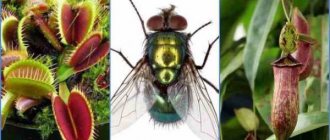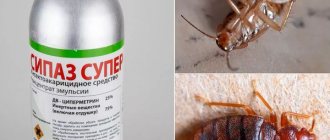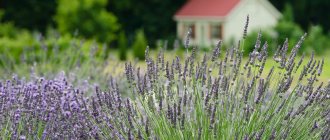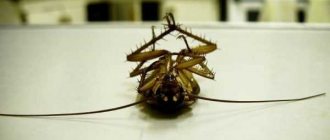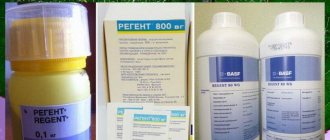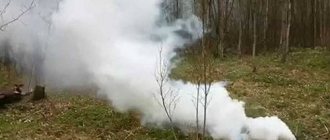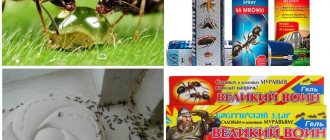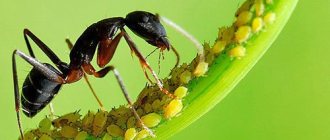Insectivorous plants - popular species, care
Plants that are capable of catching and eating insects and small animals are of extreme interest and surprise. And lovers of indoor flowers definitely try to purchase these flowers in their collections.
In nature, predator plants are found on almost all continents. They belong to 19 different families. Currently, about 630 species of these amazing creatures have been described. Most of them come from tropical areas, but there are species that feel quite comfortable in cooler regions.
So, even in the swamps near Moscow you can find round-leaved sundew (Drosera rotundifolia)
, and
the American purple sarracenia (Sarracenia purpurea)
has long been established in England and Ireland.
Sarracenia purpurea
The first descriptions of plants capable of feeding themselves by hunting appeared in the 18th century. They were compiled by the English naturalist John Ellis. The discovery was so unexpected that even many scientists of that time perceived the information with distrust.
Why did plants switch to animal food?
A plant that eats insects has evolutionarily changed its diet not because of a good life. All species of these carnivores grow on soils lacking nitrogen and other useful substances. It is very difficult for them to survive on sandy soils or peat, so some species have adapted to life thanks to the ability to digest animal protein. It is animal food that can completely renew reserves of nitrogen and minerals.
Plants use various traps to catch prey. In addition, all plant predators are distinguished by their bright colors and attractive smell, which insects associate with nectar-bearing flowers. But do not forget that animal food is only “vitamins” for plants, and the main nutrition for them is photosynthesis.
Insidious beauty
The food for predatory flowers is mainly insects. They rarely sit down for anything, except to rest a little. Beetle bugs are also constantly looking for something to profit from, such is the fate of all living creatures on the planet. Of course, carnivorous plants could simply wait for a lucky break, but then it is unlikely that most of them would survive. Therefore, they take the initiative on the same principle as people who claim that luck is in their hands. In the absence of limbs, the predator plant uses the organs at its disposal, namely leaves and flowers. You can attract capricious insects with the aroma, color and beauty that captivates bees and butterflies with harmless daisies, poppies or daffodils, the only difference being that they should be even more seductive, at least from the point of view of insects.
Varieties of carnivorous plants
To date, scientists have described about 500 species of carnivorous plants that belong to 19 families. We can conclude that the evolutionary development of these groups of organisms occurred in parallel and independently.
The most famous plants that eat insects:
- sarracenia;
- genliseya;
- Darlingtonia;
- pemphigus;
- butterwort;
- sundew;
- biblis;
- Aldrovanda vesica;
- Venus flytrap.
Interesting fact: flycatchers have the Latin name muscipula, which translated into Russian does not mean “flytrap”, but “mousetrap”.
Green jaws
of the Venus flytrap (Dionaea muscipula) look especially impressive.
. Its traps are equipped with sensitive hairs located on the inside. If they are touched, a special “closing” mechanism is triggered. Moreover, the Venus flytrap can distinguish its prey. If something inedible (for example, a blade of grass) gets into its teeth, the trap opens again and waits for its happy hour.
This trinity: sundew (Drosera),
nepenthes (Nepenthes) and Venus flytrap (Dionaea muscipula)
is now easy to find on sale. Growing them is not so easy; in unsuitable conditions they will not live long, so before purchasing you should thoroughly prepare and evaluate your capabilities.
Venus flytrap (Dionaea muscipula)
Prevalence of entomophagous plants
Carnivorous plants are not only exotic representatives of the biosphere. They are found everywhere - from the equator to the Arctic. Most often you can stumble upon them in damp places, especially in swamps. Most species have been recorded in the southwestern part of Australia. Some species are eurybionts and grow in many biocenoses. The range of other species is more limited - for example, the Venus flytrap is found in nature exclusively in South and North Carolina.
What species grow in Russia
In Russia there are 13 species of carnivorous plants from 4 genera. The genus Sundew is represented by two species: common sundew and English sundew. They grow mainly in sphagnum bogs. Aldrovanda bladderwort is found both in the European part of the Russian Federation and in the Far East and the Caucasus.
The Pemphigus genus in Russia is represented by four species, the most common of which is Pemphigus vulgaris. These are aquatic plants that differ in their growth rate. They are found in shallow waters throughout Russia (with the exception of the Far North). Also in our area you can find representatives of the Zhiryanka genus, which grow in swamps, stream banks, and some on trees and mosses.
Sarracenia - the evil queen
She comes from the New World. Lives mainly in the southern part of North America, although it is also found in Canada, but less frequently. This predatory plant uses special leaves for hunting, also called trap leaves, similar to a funnel with a hooded cape. This cover protects the hole, from which an odor tempting to insects is emitted, from rain and excessive diffusion of a secretion liquid with an aroma reminiscent of nectar. Sarracenia bait also contains a substance that has a relaxing effect on victims, similar to a narcotic effect. The surface of the leaf is smooth and slippery. Under the spell of the sweet smell, bugs or flies themselves strive to fall into this terrible funnel, from which there is no way out. Once dropped inside, the victims are digested and dissolved by protease and other caustic enzymes.
Types of Trap Organs
Predators catch their victims using trap organs, which, depending on the species, are of several types:
- pitcher leaves. This design has a lid and the inside is filled with water (Nepenthes, Darlingtonia);
- leaves-traps. The modified leaf consists of two valves with teeth on the edges. When the insect is inside, the valves close (Venus flytrap);
- Velcro leaves. On the leaf plates there are special hairs that secrete a sticky secretion that attracts insects (sundew, butterwort);
- suction traps. Water along with the victim is sucked under pressure into a special bubble (pemphigus);
- crab claw traps. Victims easily fall into them, but cannot get out because of the hairs growing forward in a spiral (genlisea).
Water
This is a subgroup of predator plants that grow in warm bodies of water. They feed on flying insects and small crustaceans. Aquatic carnivorous plants can be found, in addition to their natural habitat, only in botanical gardens, since they are very demanding on living conditions and are not suitable for growing at home.
Pemphigus
It grows in fresh water or marshy soil on all continents except Antarctica. The only carnivore that uses a bubble as a trap. It feeds on water fleas, tadpoles, insects, and protozoa. Bubble traps are under negative pressure. When prey touches the bubble, the hole opens and sucks the victim along with water in hundredths of seconds. The size of the bubbles is very small - from 0.2 mm to 1.2 cm.
Aldrovanda vesiculata
It lives only in fresh water bodies in western Europe, Africa, Asia and Australia. The plant has no roots, so it moves freely throughout the pond. It grows very quickly, but the length of the stems does not exceed 11 cm. Short 3-mm leaves-threads act as a trap. The ends of the threads are covered with sensitive bristles, which react sensitively to moving objects - crustaceans and aquatic larvae. When the prey touches them, the leaves fold and capture the prey.
Darlingtonia californica
This is a very rare carnivorous plant found in the cold swamps of Oregon and California. A truly amazing plant: it not only lures prey into its jug traps, attracting it with a sweet aroma, but also prevents it from escaping due to its ingenious internal structure with many false exits. The drugged victim wastes precious time in unsuccessful attempts to get free.
Keeping at home
The following types of carnivorous plants can be kept at home:
- Venus flytrap;
- all types of sundews;
- tropical fatworts;
- sarracenia;
- dwarf nepenthes.
In Russia, the most popular indoor predator is the Venus flytrap. The flower pot should be kept on a well-lit windowsill or on a table with artificial lighting. The indoor air temperature in summer should be between 18–25 °C, and in winter – 10–13 °C. Since the flytrap is a moisture-loving plant, the soil in the pot must be constantly moistened. The plant should be watered with clean rain or melt water.
Reproduction
Flycatchers reproduce by cuttings, dividing the bush and through cross-pollination. The flowering period of Dionaea begins in late spring. In natural biocenoses, the plant is pollinated by insects. At home, flowers need to be pollinated by hand, transferring pollen from the stamens to the stigma with a soft brush.
Top dressing
If a plant is called carnivorous, this does not mean at all that it needs to be fed meat. The flycatcher itself must hunt small insects in order to fully digest food and obtain the necessary substances. Also, do not forget that Dionaea receives its main nutrition from the ground.
Care during the rest period
During the cold season, the Venus flytrap stops its growth and falls into suspended animation. At some point it may even seem to you that the plant is dying. But this is not so, dionaea needs this condition to gain strength for the next growing season. At this time, your task will be to remove withered leaves and wait for new ones to grow.
Sundew
This carnivorous plant attracts insects with its appearance. The upper side and edges of its leaves are covered with growths containing droplets of sticky liquid, similar to dew (hence the name). When the victim is caught, the leaf begins to slowly curl. Afterwards, it digests the insect in 2-3 days and unfolds again.Sundew needs bright, diffused light. And it is better to protect it from direct sunlight, otherwise burns will appear on the leaves. Summer temperature for tropical species is 22–30 °C, in winter it is about 16 °C. For European plants in summer - 20–24 °C, and in winter - about 12 °C.
Watering should be regular, using distilled water - the soil should not dry out. Air humidity must be high - from 70%. To ensure this, you can place containers with water or wet sphagnum next to the plant, and also use a humidifier. You should not spray the sundew.
Buy seeds →
Don't forget to water
